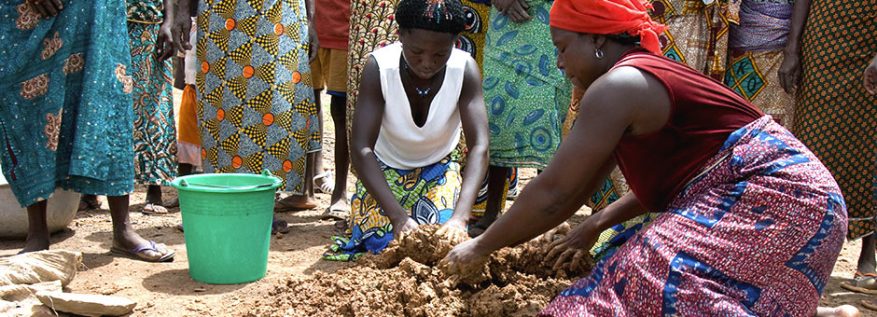The members of Malagu village womens group don’t make money from the mud stoves that they manufacture and the demonstration workshops they hold in neighbouring villages.But they do pass on the equipment and knowledge in exchange for grain, and sometimes poultry, says Yatouti Sinhari of Self Help Africa’s local partners TRAX-Togo.
‘It is a barter system. They are happy to get something from the effort, and are pleased to be able to pass on the knowledge to others’, he explains. The 15 member Malagu group manufacture the stoves from a mortar like material that they produce from mixing grain husks, clay and animal dung. The substance is mixed with water into a malleable paste, and after a period maturing in a bucket is mixed, rolled out, and moulded into the shape required to make the simple mud stoves.
The semi-enclosed firebox in this traditional improved stove design cuts down dramatically on the amount of firewood required to cook a meal, and in compounds where the stoves are located indoors has the further benefit of producing much less smoke than the open cooking fire alternative.
The Malagu Group members are amongst over 1,400 women in the Self Help Africa supported project at Dapaong in Northern Togo to have been organised into a total of 77 such women’s groups in the region. They have received training and support in a range of income generating activities, and in time will mobilise as part of a local savings and credit co-operative that will promote saving and dispense loans to support income generating activities for its women members.
In the meantime the Malagu group and a number of other womens groups involved in fabricating and promoting fuel efficient mud stoves continue with their work – which to date has distributed over 1,350 stoves to households in the locality. Group member Kolani Dunca says that she has been using an improved mud stove for more than two years, and sees the benefits of the resource every single day.
‘My daughters gather wood fuel for cooking and they now spend just a fraction of the time that they used to, collecting wood’, she says. ‘I expect that this stove will last me at least another two or three years, and then I will just make another one’.

